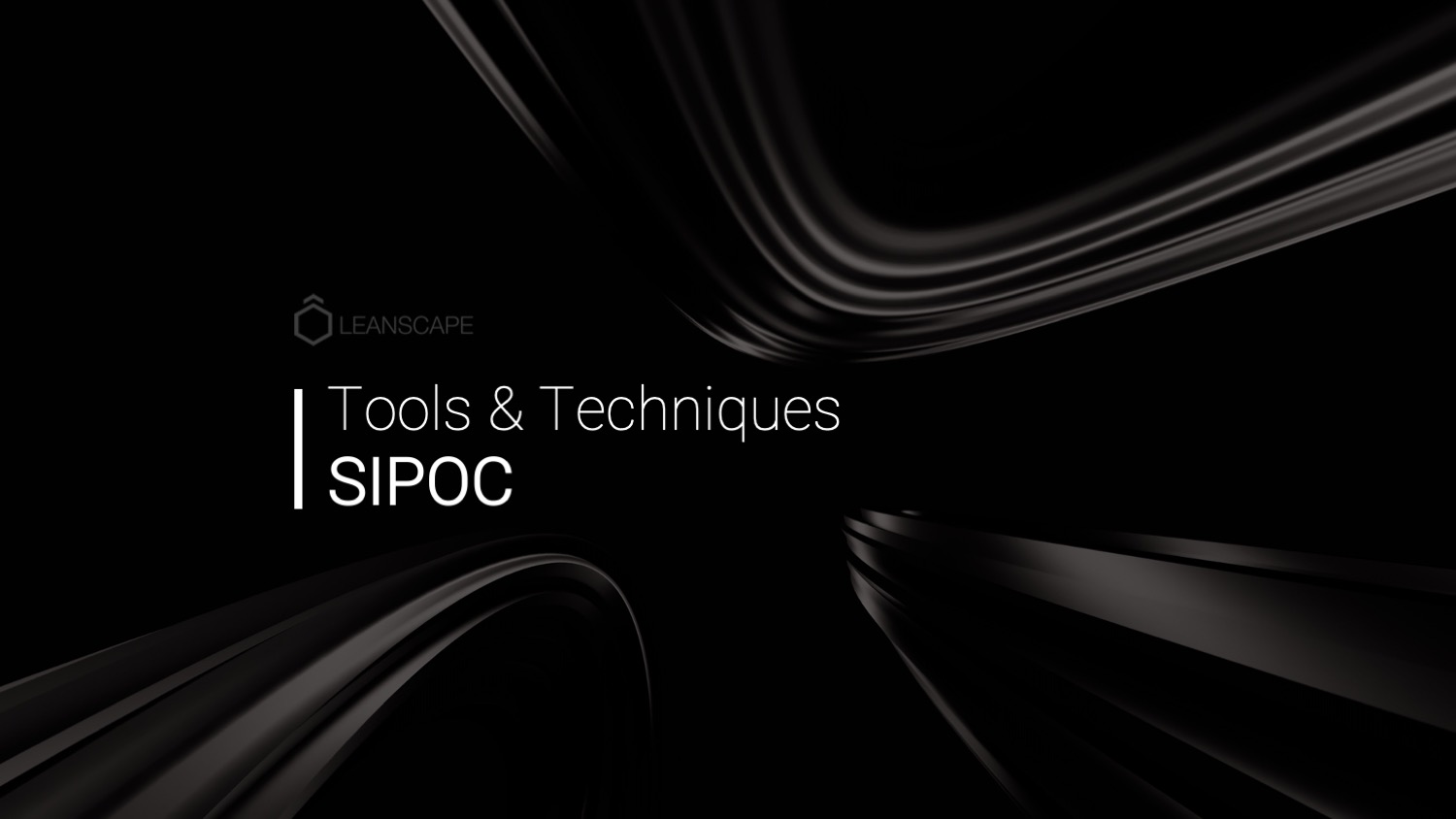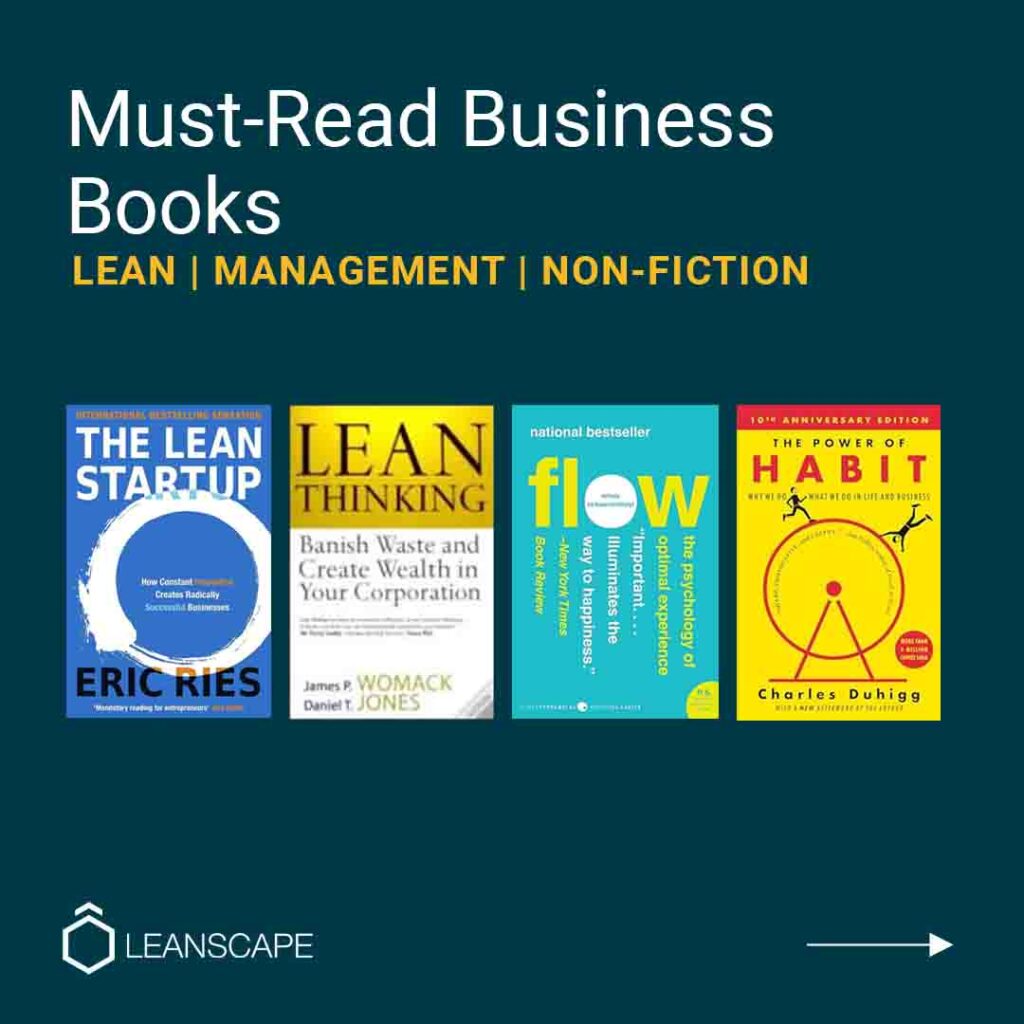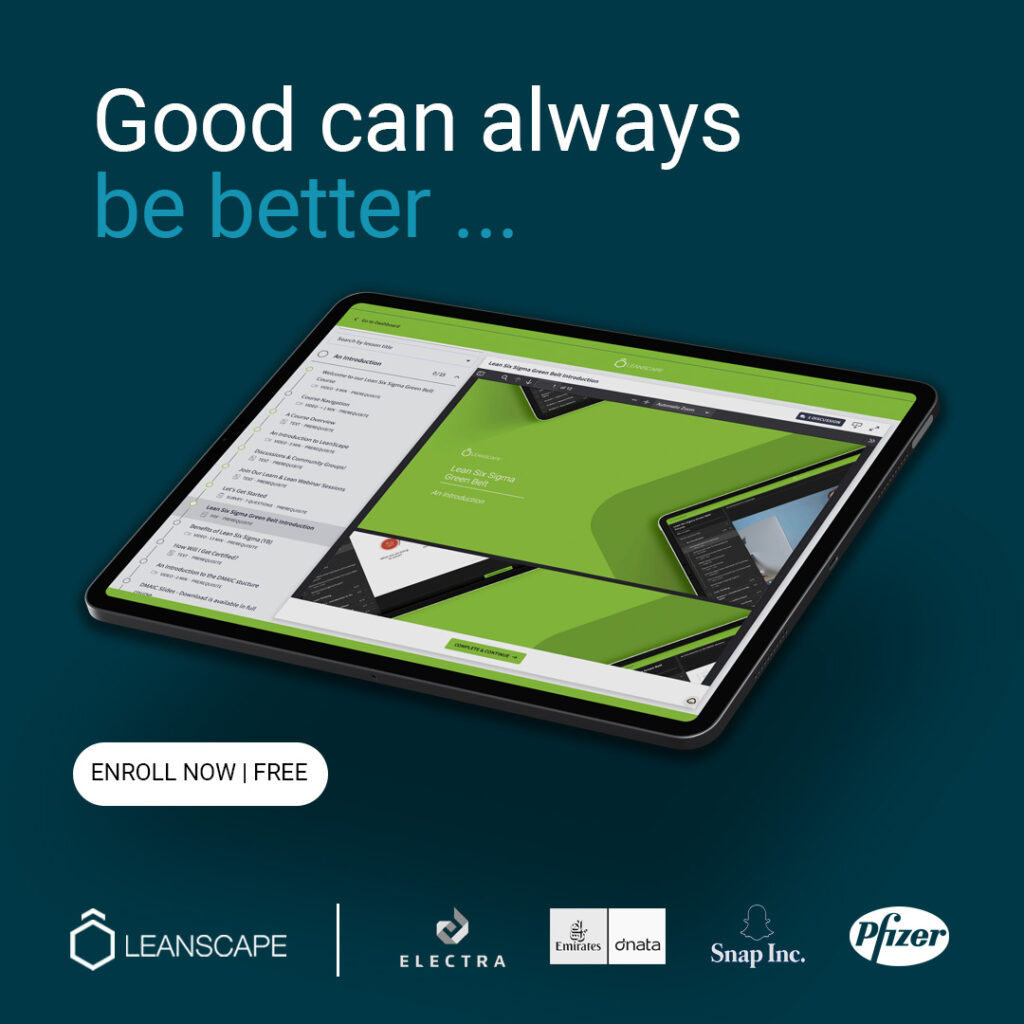The SIPOC tool is a robust process mapping framework that can help project owners develop a high-level project overview ensuring clear process inputs, process outputs, customers and suppliers are captured. The SIPOC is a high-level process map used for continuous improvement projects.
In the world of Lean Six Sigma, process improvement is critical for achieving optimal operational efficiency, reducing waste and improving the overall effectiveness of an organisation. One indispensable tool in the toolkit of Lean Six Sigma practitioners is the SIPOC (Suppliers, Inputs, Process, Outputs, and Customers) tool. In this comprehensive guide, we’ll explore what the SIPOC tool is, its components, benefits, best practices, and its place within the broader context of Lean Six Sigma methodology.
What is the SIPOC Tool?
SIPOC is a visual representation of a process that enables project teams to understand and map any process’s key elements quickly. It is often employed at the early stages of a Lean Six Sigma project to provide a high-level overview of a process, identify inefficiencies, and discuss areas for improvement.
For all business process improvement projects, we suggest doing a SIPOC during the early project development to help scope the business processes, ensure everyone is on the same page, and that the process improvement efforts can be aligned and directly impact the customer requirements.
The SIPOC is a valuable communication and collaboration tool during a process improvement project.

How does the SIPOC help process improvement
Businesses are always looking for ways to improve their processes and optimise operational efficiency, but it can be hard to know where to start.
Without a clear understanding of the process from start to finish, it’s difficult to identify inefficiencies and areas for improvement. Traditional methods of problem-solving are often too time-consuming or inefficient.
The SIPOC tool is an essential component in Lean Six Sigma projects that provides a framework for mapping out a process from start to finish. It stands for Suppliers, Inputs, Process, Outputs and Customers (hence SIPOC) and helps identify who or what is involved at each stage of the process. By understanding how these elements interact, the SIPOC allows organisations to develop more efficient business processes that can be measured and improved upon quickly and easily. With its structured approach to problem-solving and streamlining business operations and business process thinking, mastering the SIPOC tool should be a priority for anyone who wants to ensure the business process function properly and those looking to optimise workflows.
What is the difference between SIPOC and process maps?
The SIPOC tool is used to provide a high-level overview of a process. It identifies the key suppliers, inputs, processes, outputs, and customers involved. A SIPOC diagram can be represented as a table or a flowchart and is typically used at the start of a project to ensure everyone involved understands how the process works.
A process map, on the other hand, provides more detailed information about each step in the process and its inputs/outputs. It outlines all activities within a particular process and their interdependencies, indicates where decision points occur, and highlights areas for potential improvements. We use process maps or activity maps to find waste within the process. In contrast, a SIPOC is used to align the team, align relevant stakeholders, identify suppliers, and ensure key components and key process steps are captured but not in too much detail.
In our view, the SIPOC is a level one process map used to ensure each process step has key inputs required, outputs understood and that the project specifications remain clean. Activity maps are level four maps that capture the click-level activities directly impacting customer requirements. The SIPOC model remains a high-level process map not designed to identify the individual process-related issues but to identify the key steps and align the teams on the project’s scope.
Components of the SIPOC Tool
To harness the maximum potential of the SIPOC tool, it’s imperative to understand each of its components. Let’s delve into each element with examples for better comprehension:
1. Suppliers: These are the individuals, departments, or entities that provide the necessary inputs for a given process. For instance, in a manufacturing setting, a supplier might furnish raw materials required for production.
2. Inputs: Inputs are the resources, materials, or information required for a process to run smoothly. Using the manufacturing example, inputs could include raw materials, equipment, and a skilled labour force.
3. Process: A process is a series of steps or activities that transforms inputs into outputs. This can be broken down into distinct steps – ideally between 5 to 9 steps – to ensure simplicity and easy understanding. In our manufacturing example, the process could involve unpacking raw materials, operating machinery, assembling products, and packaging finished goods.
4. Outputs: Outputs are the end results or products generated by the completion of a process. In the case of our manufacturing example, the output would be the final, fully assembled product.
5. Customers: Customers are the recipients of the outputs. They could be internal stakeholders such as other departments or external clients who purchase the final product.
The SIPOC diagram is a key Lean Six Sigma DMAIC methodology and one of the core process mapping tools used to map business processes.
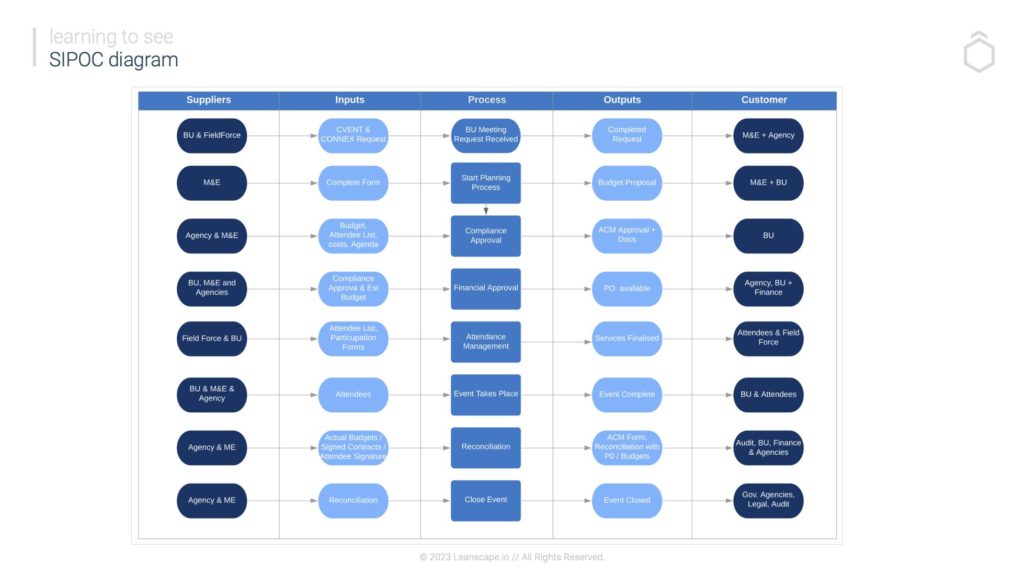
Benefits of Using the SIPOC Tool – Business Process
Utilising the SIPOC tool in Lean Six Sigma projects offers several advantages, such as:
* Identifying process inefficiencies: By creating a visual representation of a process, inefficiencies and bottlenecks can be swiftly detected and flagged for improvement.
* Improving communication: A SIPOC diagram fosters collaboration and alignment among team members, helping them better understand their specific roles and responsibilities and ensuring a shared understanding of the process.
* Reducing defects: SIPOC can spotlight areas where errors or defects may arise, offering valuable insights into potential process improvements to minimize such occurrences.
Best Practices, Tips, and Common Mistakes
To make the most out of the SIPOC tool, keep these best practices, tips, and common pitfalls in mind:
* Begin by listing out the Process steps first: This allows you to focus on the core activities before considering Suppliers, Inputs, Outputs, and Customers.
* Limit Process steps to 5-9: Restricting the number of steps will ensure a clear, concise, and easily digested visual representation. More than this and the SIPOC can begin to look more like a standard process map for details views of the business process.
* Don’t forget to consider customer feedback: Regularly incorporating customer feedback into SIPOC diagrams can help identify potential improvement opportunities that might not have been detected otherwise.
* Avoid ambiguous or overly technical language: Using complex terminology or jargon can make the diagram difficult to decipher and confuse stakeholders.
* Remember that SIPOC diagrams are living documents: The SIPOC diagram should be updated and modified as needed to reflect any changes made to the process.
By following these guidelines, you can ensure the maximum effectiveness of the SIPOC tool for your Lean Six Sigma project.
Download a SIPOC Template
If you want to get started with the SIPOC diagram, you can use one of our SIPOC templates to get started. Our SIPOC diagram template is designed to help you create a SIPOC Diagram, keep your team on the same page and build strong business processes. https://miro.com/miroverse/sipoc-process-map/
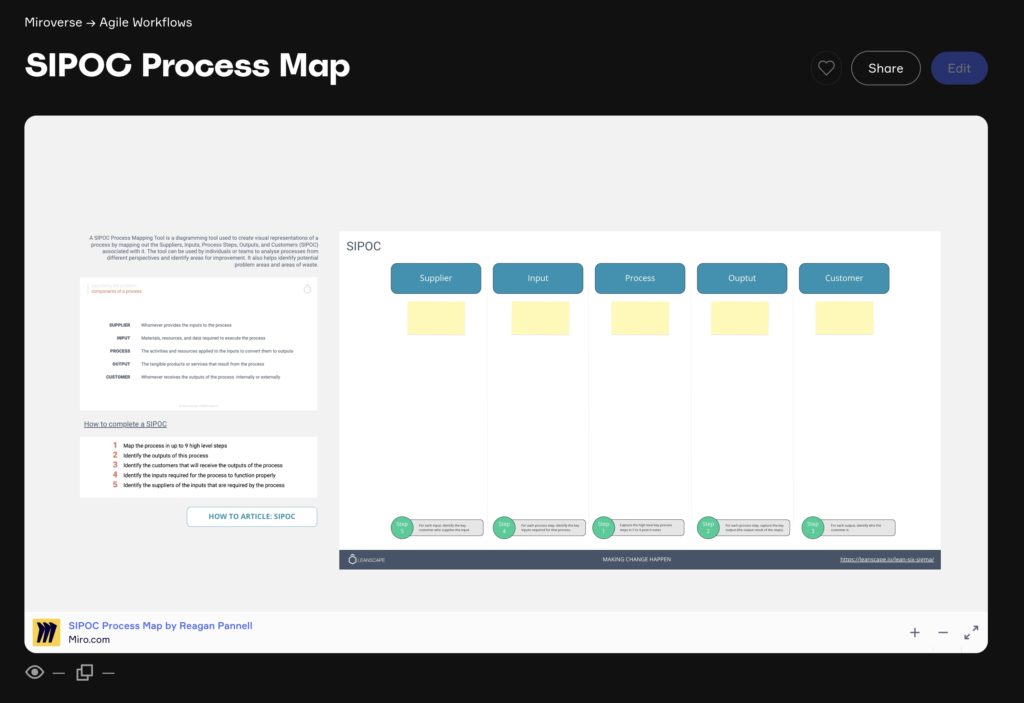
Real-world examples of SIPOC in action
Let’s look at a few real-world examples to better understand how SIPOC works in practice. One company used SIPOC to analyse their order fulfilment process and discovered that a significant amount of time was wasted due to miscommunication between departments. Implementing a new communication system and clarifying roles and responsibilities reduced their order fulfilment time by 30%. Another company used SIPOC to analyse their hiring process and found they were losing top candidates due to a slow and confusing application process. By streamlining the application process and providing more precise instructions, they were able to improve their candidate experience and increase their hiring success rate.
SIPOC Diagram Summary
The SIPOC tool can be a powerful asset in identifying areas for process improvement and optimising efficiency. With an understanding of its key elements and best practices, you can utilise the tool to get the most out of your project – from start to finish.


